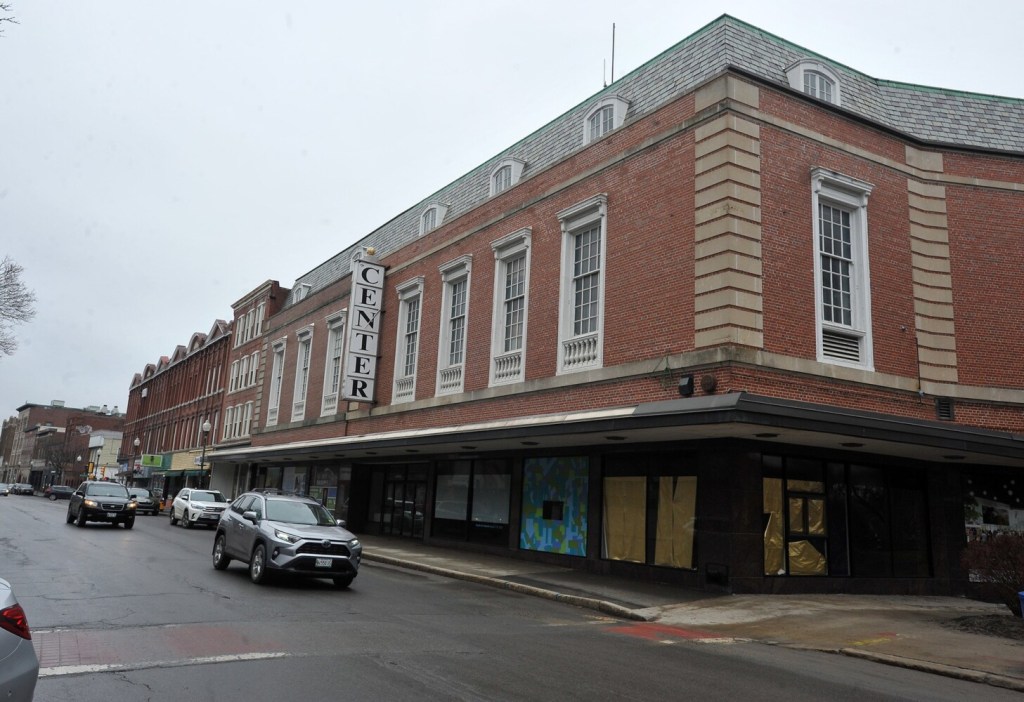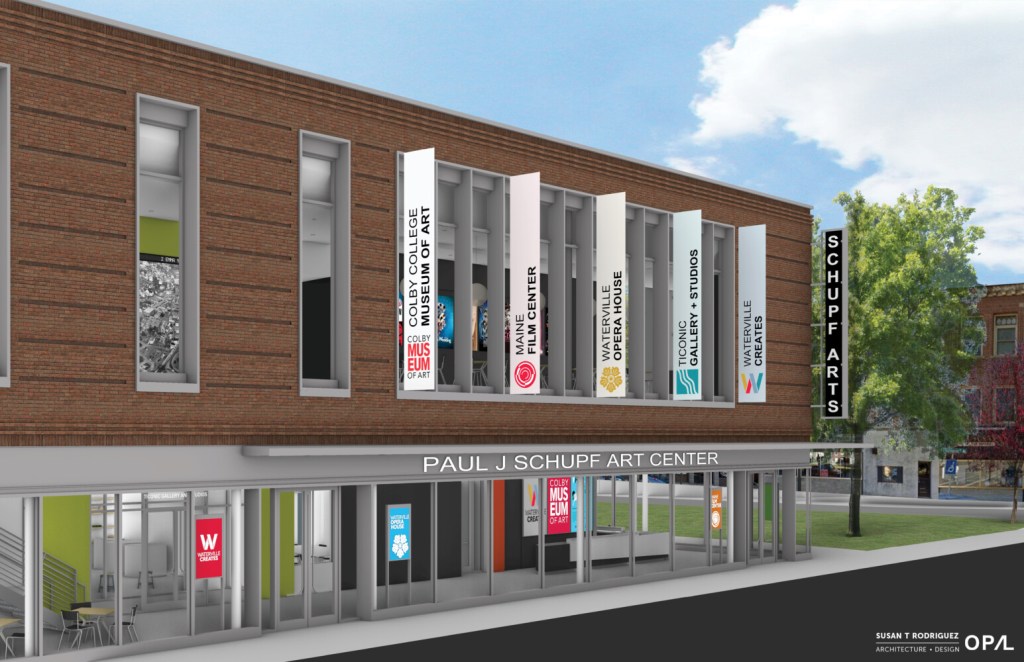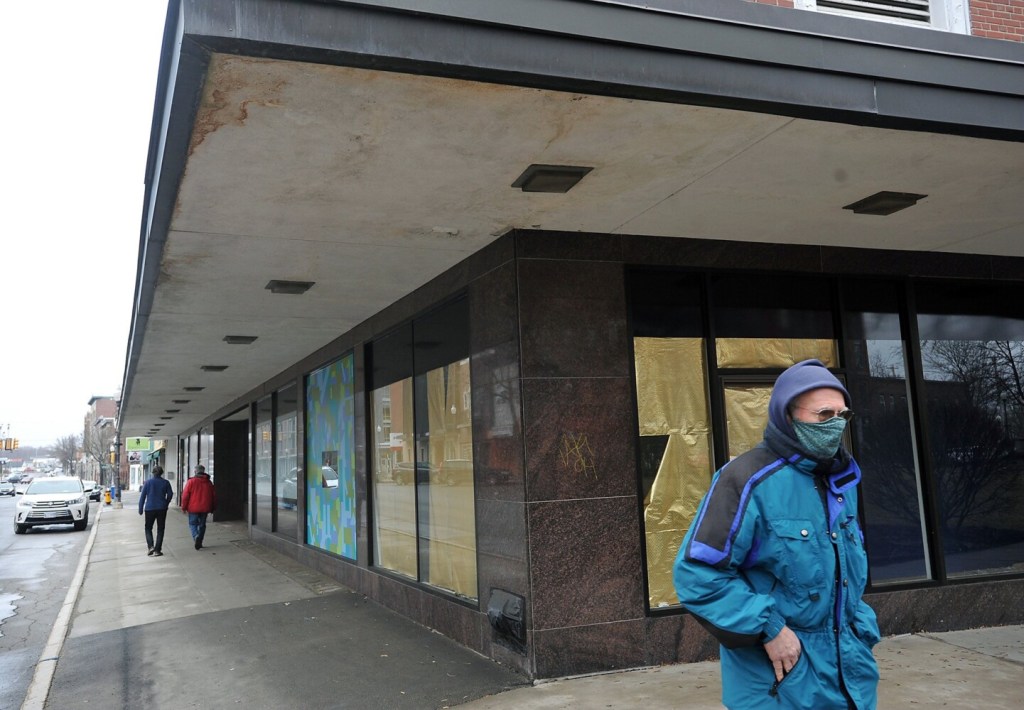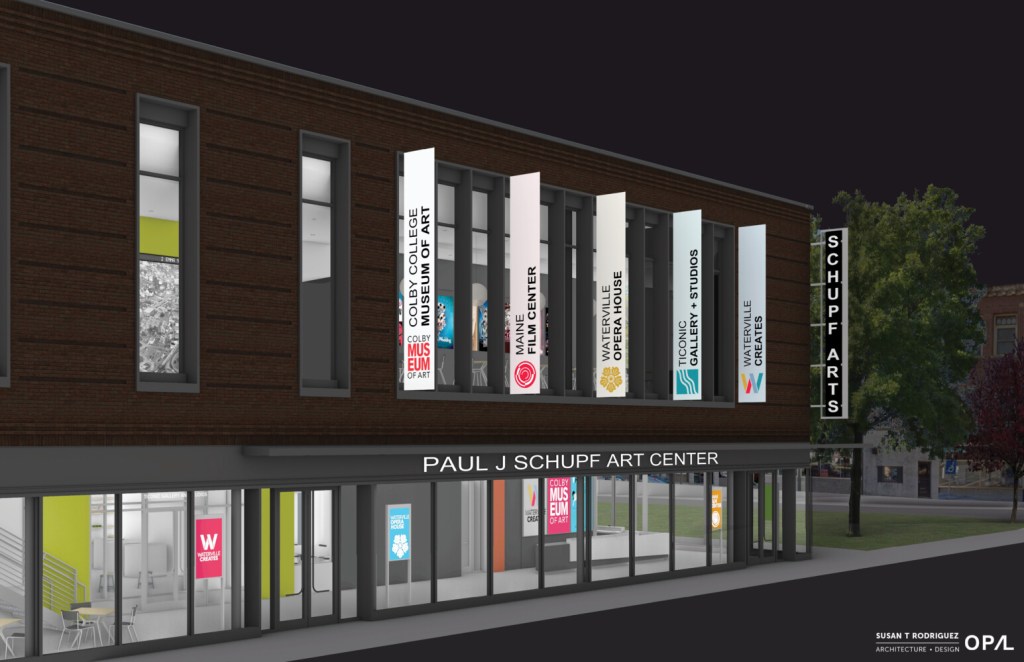WATERVILLE — The face of downtown will once again change and grow as work starts Monday on an $18 million project to develop the Paul J. Schupf Art Center at 93 Main St.

The original plans have changed. Project officials originally planned to maintain the façade of the building on the Main Street side, but they determined the building needed a complete redesign for the project to get underway. Colby President David Greene, who had been one of the strongest advocates for maintaining the façade, said keeping it would have required a construction delay of about six years.
The center, named for Schupf, an art collector, Colby benefactor and emeritus trustee of the college, is designed to be a hub and destination place for the visual and performing arts, arts education, and film for people of all ages. Colby and Waterville Creates!, a nonprofit organization that supports and promotes art and culture in Waterville, have been working together on the project.
Greene said this past week that art spaces traditionally are hidden or closed venues for which people must be invited in, but the Schupf Center will require no invitation.
“The arts are for everyone. Everyone is welcome, and this building is a community building,” he said.
The Waterville Planning Board on April 5 is scheduled to review a preliminary plan for the project, expected to be completed in the fall of 2022. Those wanting to join the virtual meeting must contact City Planner Ann Beverage to receive a link.

The building at 93 Main St. is being remade into the Paul J. Schupf Art Center in Waterville. Rich Abrahamson/Morning Sentinel Buy this Photo
The center work starts as millions of dollars have been, and continue to be, invested in the downtown. The revitalization efforts are reflected in Colby’s new Lockwood Hotel featuring Front & Main restaurant; the Arts Collaborative across the street; the Bill & Joan Alfond Main Street Commons which houses Colby students and staff, Camden National Bank, community space and a future restaurant; the renovated former Waterville Savings Bank into retail and office space; and several other redevelopment and restoration building projects by other people, including businessman Bill Mitchell.
Also, an $11.2 million revitalization project by the city, Colby, the state Department of Transportation and downtown businesses and building owners, was launched last week to change the traffic pattern on Main and Front streets from one way to two, improve intersections and sidewalks, and beautify downtown with new landscaping.
“It feels like a very important moment,” Greene said.
Greene and Brian Clark, Colby’s vice president of planning, Waterville Creates! Executive Director Shannon Haines, and Jim LaLiberty, chairperson of the Waterville Creates! board of directors, said in a Zoom interview that the Schupf Center has been talked about for years and now the work will begin to see it come to fruition. It will be a place where all the arts in Waterville will come together in one place.
“This is such an exciting project for everyone involved — for the entire community, for our whole region,” LaLiberty said. “My view of this from the beginning was, this is the real capstone of everything that is happening on Main Street. It is a project that is really going to affect the history of this city for a long time. It will still be here 100 years from now, and it will still have an impact after we’re all gone.”
THE SCHUPF CENTER
Waterville Creates! and Colby have raised close to the $18 million needed for the new center, with LaLiberty having led the fundraising campaign. Haines said $850,000 has been raised so far as part of a goal to raise $1 million from within the community itself.
“That represents over 125 gifts from businesses, individuals and foundations,” she said.
The community, Haines said, has always embraced and supported the arts, and the center will allow for programs to be expanded and will serve to draw in more patrons.

The newly conceived and redesigned Paul J. Schupf Art Center. Courtesy of Susan T. Rodriguez, Architecture Design
“I think this is one of the most important projects happening right now,” she said.
On Monday, construction fencing and equipment will arrive at the site and demolition of the building will begin later in the week and continue into mid-June, according to Clark. Then the steel will go up and the building is expected to be fully enclosed by January next year.
The beautiful, thoughtfully-designed building with its brick work, glass and openness is just the right combination for Waterville, according to Greene.
“The building very much reflects the history of Waterville and tells us something about where Waterville is going,” he said.
Haines said 93 Main St. is actually two separate buildings that were joined in 1967. The southernmost part of the building was built in 1938, and the earlier section in the late 1800s. Before the building was closed a couple of years ago, it housed the Waterville City Council chamber, planning and code enforcement offices, a dance studio, the former Maine Made & More shop, the community group REM, a small theater, a television studio, and more. Years before that, it was the site of Montgomery Ward and later Sterns, a department store.

The newly conceived and redesigned Paul J. Schupf Art Center. Courtesy of Susan T. Rodriguez, Architecture Design
The Schupf Center will be 29,932 gross square feet in size and feature an all-glass front facing the Castonguay Square park area, where people may gather and sit in a café-like setting with a view of the square and downtown.
The first floor will feature the Joan Dignam Schmaltz Gallery of Art, Ticonic Gallery and Studios (to include a clay studio) and the Ed Harris Box Office, which will serve all programs in the building, as well as the Waterville Opera House. The Opera House will be accessible via a new skywalk to be built flush with the building so as to provide better accessibility to the Opera House.
Three cinemas on the second floor will replace those currently at Railroad Square and will be the focal point for the Maine Film Center and the Maine International Film Festival.
DOWNTOWN REVITALIZATION
Though discussions about downtown revitalization have been ongoing for years, Greene several years ago headed up meetings with city officials, arts advocates, business leaders and others to help determine what the downtown needed to become a thriving city center.
The group decided that the downtown needed more people living and working downtown, that vacant and dilapidated buildings needed to be redeveloped and occupied and the arts supported and expanded.
Colby began buying empty buildings and redeveloping them; the college also demolished some buildings and constructed anew. Others, including Mitchell, owner of GHM Insurance Agency, followed suit, buying up buildings on Common Street and redeveloping them into various uses, including The Proper Pig restaurant, offices and residential spaces.

The building at 93 Main St. is being remade in the Paul J. Schupf Art Center in Waterville. Rich Abrahamson/Morning Sentinel Buy this Photo
The large glass curtain on the south side of the Schupf Center, and its many windows facing Main Street, will enable not only those inside to see Main Street and the people on it, but also allow those on Main Street to view what is going on inside, creating a transparency expected to draw people into the center, according to Greene and Haines.
Before Schupf, of Hamilton, New York, died in 2019, he contributed to the project in what Greene at the time called “a remarkable gift” that led to the center’s being named for him. Schupf, Greene said, loved Waterville and had a shared vision for what the center could be in the heart of downtown.
“He wanted his legacy to be here,” Greene said.
He noted that support from the Harold Alfond Foundation also was critical in ensuring the center would become reality.
“They too recognized the extraordinary opportunity we had here and how this would be a fulcrum project for Main Street,” he said.
Not since the entire community gathered for hockey games in the 1960s and early ’70s has there been a space in Waterville where everyone could get together, creating an electric atmosphere, according to LaLiberty.
“That kind of electricity is what I’m most excited about, and I think we’re going to have that at the Schupf Art Center,” he said. “I think it will be a place to go and meet people and run into friends in a way that we did in the ’60s,” he said.
Send questions/comments to the editors.










